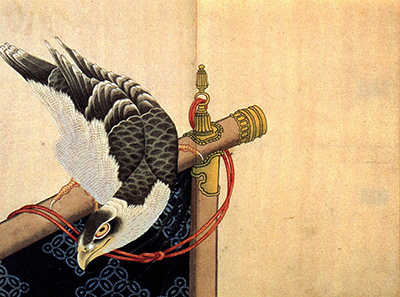Hokusai
Hawk on a Ceremonial Stand by Hokusai
Hawk on a Ceromonial Stand is one of the revered Japanese artist Hokusai’s only works that depicts an animal or animals. He was much more well known for his landscape painting that showed the effects of the harsh elements of the Japanese weather system, like The Great Wave.
The style of the painting is still in Ukiyo-e, which is the style the artist is most famous for, and has influenced many other artists in other countries like Picasso. The painting itself is of a Hawk, standing on a traditional ceremonial stand. Rather than be facing forward, the hawk is looking very sharply to the left, making the viewer wonder what the hawk is looking at outside of the painting. This leaves an air of mystery and makes the viewer of the painting wonder what the hawk is looking at.
Katsushika Hokusai was a famous painter and print maker well known during the Edo period. His most famous works are his two well known woodblock print series Thirty-six Views Of Mt Fuji and The Great Wave. For most of his life, he created woodblock paintings of landscapes, but he occasionally branched out and painted paintings that showed humans or animals. At the height of his career, he achieved notoriety by painting a 600 feet painting of the Buddhist monk Daruma. It was showed at a Tokyo festival, and his gamble to be different paid off, as after that he enjoyed much fame as an artist.
It wasn’t until his later life that he painted the two woodblock series he is well known for. In an unlikely scenario for an artist, he created most of his important work after the age of 60. It is said that the Ukiyo-e style, and Hokusai himself have influenced a great number of artists we know well today, and his art was part of the Impressionism movement. Artists such as Degas, Manet and Van Gough are said to have been fans of the artist himself and also of Japonism, which was a craze for collecting Japanese art, that helped circulation of his paintings. Even Monet and Renoir are said to have been influenced by Hokusai’s bold colours and strong contrasts of nature vs man.
